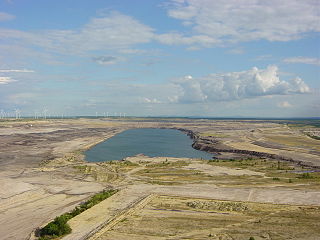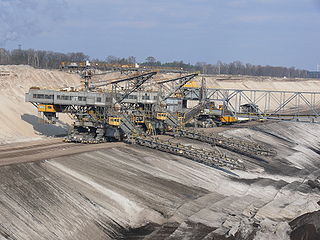
Coal mining is the process of extracting coal from the ground or from a mine. Coal is valued for its energy content and since the 1880s has been widely used to generate electricity. Steel and cement industries use coal as a fuel for extraction of iron from iron ore and for cement production. In the United Kingdom and South Africa, a coal mine and its structures are a colliery, a coal mine is called a "pit", and above-ground mining structures are referred to as a "pit head". In Australia, "colliery" generally refers to an underground coal mine.

Surface mining, including strip mining, open-pit mining and mountaintop removal mining, is a broad category of mining in which soil and rock overlying the mineral deposit are removed, in contrast to underground mining, in which the overlying rock is left in place, and the mineral is removed through shafts or tunnels.

Bagger 288, previously known as the MAN TAKRAF RB288 built by the German company Krupp for the energy and mining firm Rheinbraun, is a bucket-wheel excavator or mobile strip mining machine.

A bucket-wheel excavator (BWE) is a large heavy equipment machine used in surface mining.

Jänschwalde Power Station is located near the village of Jänschwalde in Brandenburg on the German-Polish border. The lignite-fired power station has an installed capacity of 3,000 megawatts and consists of six 500 MW units. It is the third-largest brown coal power plant in operation in Germany and is currently owned by EPH, who took over its ownership from Vattenfall in 2016.

A landship is a large land vehicle that travels exclusively on land. Its name is meant to distinguish it from vehicles that travel through other mediums such as conventional ships, airships, and spaceships.
TAKRAF Group (“TAKRAF”), is a global German industrial company. Through its brands, TAKRAF and DELKOR, the Group provides equipment, systems and services to the mining and associated industries.
The Landkreuzer P 1500 Monster was a purported German pre-prototype super-heavy self-propelled gun designed during World War II. While it is mentioned in a number of popular works about World War II projects, there is no solid documentation for the program’s existence, and it may have only been a semi-serious proposal, or even an outright hoax, much like the Panzer IX and Panzer X.

P&H Mining Equipment sells drilling and material handling machinery under the "P&H" trademark. The firm is an operating subsidiary of Joy Global Inc. In 2017 Joy Global Inc. was acquired by Komatsu Limited of Tokyo, Japan, and is now known as Komatsu Mining Corporation and operates as a subsidiary of Komatsu.

Spreaders in mining are heavy equipment used in surface mining and mechanical engineering/civil engineering. The primary function of a spreader is to act as a continuous spreading machine in large-scale open pit mining operations.

The Visonta Coal Mine ([]) is an open pit lignite mine located near Gyöngyös, Heves County, in Hungary. It is the smallest lignite mine in Hungary out of three lignite mines in total. The mine has coal reserves amounting to 400 million tonnes of lignite, one of the largest coal reserves in Europe and the world and has an annual production of 3.9 million tonnes of coal.

A bucket chain excavator (BCE) is a piece of heavy equipment used in surface mining and dredging. BCEs use buckets on a revolving chain to remove large quantities of material. They are similar to bucket-wheel excavators and trenchers. Bucket chain excavators remove material from below their plane of movement, which is useful if the pit floor is unstable or underwater.

Bertzit Tower is an investment ruin in the north of Kahla, which belongs to Plessa in the southern part of Brandenburg, itself part of the Elbe-Elster region.
A conveyor bridge is a piece of mining equipment used in strip mining for the removal of overburden and for dumping it on the inner spoil bank of the open-cut mine. It is used together with multibucket excavators, frequently bucket chain excavators, that remove the overburden which is moved to the bridge by connecting conveyors. Conveyor bridges are used in working horizontally layered deposits with soft overburden rock in areas where mean annual temperatures are above freezing. They are frequently used in lignite mining.

The Bergheider See, south of Finsterwalde near Lichterfeld in the county of Elbe-Elster in Germany, is a flooded pit from the former open cast mine of Klettwitz-Nord, northeast of the Lower Lusatian Heath. The lake was named after the old village of Bergheide, which had to be abandoned for the brown coal pit.

Bagger 1473 is a bucket-wheel excavator left abandoned in a field in the municipality of Schipkau in Germany.

Lake Puketirini is a former opencast coal mine, immediately to the west of Huntly and east of the larger, but much shallower Lake Waahi, in the Waikato Region. It is circled by a walkway.

The Meuro mine was a former open-cast mine located in the state of Brandenburg, Germany that was in operation from 1958 to 1999. It was a source of lignite, often referred to as brown coal, which was used in local factories and power stations. It was one of a number of mines in the Lusatia area which left a massive water debt when the water was pumped out for the operation of the mine. This had to be remediated by the company, Lausitzer und Mitteldeutsche Bergbau-Verwaltungsgesellschaft (LMBV), a state-owned company. The area was flooded and converted into a multi-use recreation and tourism area.

The Rheinisches Braunkohlerevier, often called the Rhenish mining area, is a lignite mining area or district in the Cologne Bay, on the northwestern edge of the Rhenish Slate Mountains. The mining of lignite using the open pit method has had a significant impact on the landscape here and led to the formation of several important industrial sites. The area includes the Zülpicher and Jülicher Börde, the Erft lowlands and the Ville, making it the largest lignite mining area in Europe. To a lesser extent clay, silica sand and loess are mined here. The area is the only active lignite mining area in what was West Germany during German partition and contains the mines with the largest surface area, greatest depth, and biggest annual output of coal.

The Type Es 3750 or simply the Es 3750 is a series of bucket chain excavators built by TAKRAF and used in Germany. According to TAKRAF, they boast that the Type Es 3750 is the largest bucket chain excavators in the world. Type Es 3750s are notable for being always used in conjunction with the Overburden Conveyor Bridge F60, another absurdly large land vehicle.


















